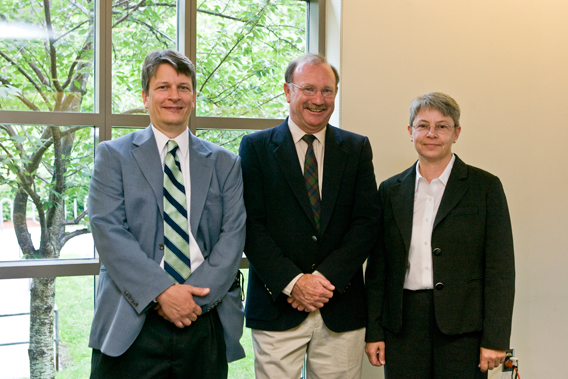A Very Curious Mind
New biography charts the life of Tufts professor Allan Cormack, inventor of the CAT scan and Nobel laureate
By Helene Ragovin
The Nobel Prize was beside the point.
Allan MacLeod Cormack-physicist by training, scientist by nature, beloved and distinguished member of the Tufts faculty who shared the Nobel Prize in medicine for his development of the CAT scan-did not pursue his work in search of fame or fortune. In fact, he never even applied for a patent for computerized axial tomography, the technology that revolutionized radiology and the field of medical diagnosis.

Author Christopher Vaughan (center) with Robert Cormack and Jean Cormack, J80, the children of Allan Cormack. Photo: Joanie Tobin
"You know, I went into physics to do physics, not to make money or that sort of thing," he once said.
Cormack's life and work is the subject of a new book by biomedical engineer Christopher "Kit" Vaughan, titled Imagining the Elephant: A Biography of Allan MacLeod Cormack (Imperial College Press). To help launch the book, Vaughan spoke at Tisch Library in early August, a packed-room event attended by members of the Cormack family, including his daughter, Jean Cormack, J80, and his son, Robert, and many of Cormack's Tufts colleagues and former students.
Like Cormack, Vaughan is a native of South Africa and teaches at the University of Cape Town, Cormack's alma mater and the place where he conducted the early experiments that would lead to the development of tomography. While Vaughan never personally talked with Cormack, who died in 1998, he was motivated to tackle his biography by a desire to honor one of his nation's scientific heroes.
Cormack taught at Tufts for 37 years, starting in 1957, and at first glance, it's easy to assume that the "elephant" in the title of Vaughan's book refers in some way to the university mascot. Not so. Over the course of a weekend, Vaughan said, he searched for a title that would be "intriguing and enigmatic." He at last hit on the idea of alluding to the Indian fable about six blind men exploring an elephant, and the poem by John Godfrey Saxe that the legend inspired. Indeed, the concept of explaining tomography using an elephant-a beast best examined from many angles to obtain the "complete picture"-is one that has been used by other science writers as well, Vaughan said.
"The CAT scanner allows us to uncover the identity of objects that would otherwise be hidden in a traditional two-dimensional X-ray image," Vaughan said.
In 1981 and 1994, Vaughan had the opportunity to attend lectures delivered by Cormack, and from the audience, was struck by Cormack's "joie de vivre and genuine love of science."
"Although I was never formally introduced to Allan MacLeod Cormack, I feel that I have come to know him well these past four years," Vaughan said.
Many at Vaughan's talk did know Cormack well, and were eager to share their recollections-and to thank Vaughan for allowing them a glimpse into Cormack's early life.
"Allan did research because it was fun and challenging, not because of external glory or credit, and the choice of Allan's research topics shows how playful Allan was intellectually," said E. Todd Quinto, a professor of mathematics who was mentored by Cormack during his early career at Tufts and also co-authored three articles with him.
Quinto recalled a line from the book in which Cormack said, "I always enjoy solving problems wherever I find them."
Quinto said of his colleague, "I saw from his actions how to be a scientist by watching his curiosity, his lack of fear about asking important questions and his strong desire to understand. . . . Allan was the best sort of scholar. He did research because he was incredibly curious and wanted to understand."
His friends, colleagues and students remember Cormack as a modest man, with a self-deprecating sense of humor, an intense sense of focus and a love of baseball.
Robert Schneider, G68, who studied with Cormack as a graduate student, remembers attending a seminar Cormack gave on November 22, 1963, shortly after the campus learned that John F. Kennedy had been shot. "He managed to get through that seminar with such aplomb and gave his lecture, even though the rest of us were all falling apart," recalled Schneider.
Former provost and physics professor Kathryn McCarthy, J44, G46, shared a favorite story about Cormack going for a medical test at Massachusetts General Hospital with his wife, Barbara. A young doctor was asked to show them to the CAT scan room, and not much was said until they reached the room housing the scanner. On the wall was a plaque, with the image of Cormack and an explanation of how he had won the Nobel Prize for developing the scanner. The doctor glanced from Cormack to the plaque, and back.
"Allan said he wasn't sure whether the internist was going to faint-he practically had to carry him into the room," said McCarthy, prompting great laughter from audience.
Helene Ragovin may be reached at helene.ragovin@tufts.edu.


